
12 minute read
FEATURE
An image of KSO musicians playing from the Prometheus Project video that was produced by KSO Music Director Julian Kuerti.
When the Kalamazoo Symphony Orchestra begins its 100th season this month, it will be a memorable milestone celebration. It won’t look exactly like what the board, leadership and musicians had been planning for years, but that’s 2020 for you.
Advertisement
As an organization that has survived the Great Depression, World War II and the 2008 recession, the KSO has a proud history of being malleable and adaptable. As well as grateful.
When its season begins in October, it will do so with an online “thank you” event for the community.
“An organization doesn’t reach 100 years on its own,” says Executive Director Jessica Mallow Gulley, who joined the KSO in December. “We’re preparing a presentation of two major orchestral works surrounded by videos from our partners in the community, so we can actually thank Kalamazoo for helping us turn 100.”
And while hope cannot be considered a strategy, it plays an integral part in facing the unknown.
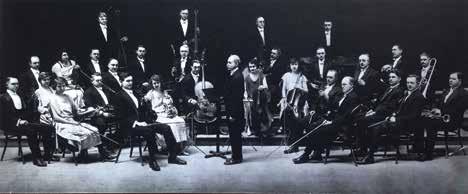


“Rethinking the entire season from the ground up — and such an important season — has been challenging,” admits Julian Kuerti, the KSO’s music director since mid2018, “but it has given us a chance to create experiences we wouldn’t have considered.”
In addition to the October thank-you event, live-streamed and recorded events will continue through the end of the year, with live performances set to return in January.
“This summer (was) all about imagination,” says Resident Conductor Daniel Brier, who completes the leadership trio working to meet the challenges the organization faces this year because of COVID-19. He’s the veteran of the three, having been on staff with the KSO since 2014. “Usually we work years ahead, so adapting to work in the moment has been kind of fun,” Brier says. “It’s been like a puzzle. We’ve built all our plans with contingencies, as there are so many different ways it may all shake out.”
“Musically, this has been difficult,” says Kuerti of his time in self-isolation due to the pandemic. “Remember, as conductors, we don’t produce any music. It’s in our heads until we can stand in front of the musicians who can play for us.” The Prometheus Project
Early in the statewide shutdown, Kuerti recruited dozens of KSO musicians to record themselves playing Beethoven’s Overture to the Creatures of Prometheus.
“It was a welcome diversion and kept us working together,” Kuerti says of the project, which debuted on YouTube in April and can be seen at tinyurl.com/KSOPrometheus.
He says he was "absolutely not” a video editor before, but he taught himself how to sync 36 performances into a final product.
Kalamazoo native and KSO bassist Noah Krzan was one of the performers. “Maestro Kuerti poured his heart into this,” says Krzan. “It was certainly different to perform alone in my living room, playing the bass into a phone, listening with one ear to the click track — an audio metronome that helps sync the parts together. I know I'm biased, but if you check out the many similar projects that orchestras put out this spring, our project sets the standard musically and in its visual aesthetics.”
Kuerti and Brier both have contracts with music organizations in other cities — Kuerti with Orchestre Métropolitain de Montreal in Canada and Orquesta Sinfónica Universidad de Concepción in Chile, and Brier with Opera
Clockwise from top: The symphony in its first year; KSO Music Director Julian Kuerti; and the KSO performs the score live while the movie Star Wars plays.
Wilmington (North Carolina) — just as many of the KSO musicians also play with other groups, teach, and/or compose. When asked how Kalamazoo compares to, say, Montreal or Santiago, Kuerti’s answer is gratifying.
“Kalamazoo is a small town with a worldclass appetite for music and culture,” he says. “I joke that the audiences in Kalamazoo are often more attentive than audiences I encounter in Montreal.” Symphony origins
The KSO is the state’s third largest orchestra, with an operating budget of nearly $3 million and 80-plus musicians and 18 professionals employed full or part time. It is supported by a host of donors, sponsors, funders and volunteers, including a board of nearly 30. The symphony provides more than 30 concert performances yearly, reaching more than 40,000 music lovers.
Founded by Leta G. Snow, the KSO held its first concert on Dec. 18, 1921, when Chester Z. Bronson conducted 25 volunteer musicians in a performance at the Kalamazoo Masonic Temple (a building that became the Rose Street Market and is now being renovated into a hotel). A retrospective created for the KSO’s 75th anniversary can be found
Thank you for 100 years of making beautiful music.

at kalamazoosymphony.org, and a 100th anniversary book is in the works.
Among the points of pride in this historical year is that, despite the economic impact of the pandemic, the KSO has cut no jobs and no one’s pay.
“We couldn’t be prouder to be honoring our financial commitments to our staff and musicians,” says Mallow Gulley, adding that the organization received federal payroll assistance and emergency support from the Michigan Council for Arts and Cultural Affairs.
Together, We are First.
FNBMichigan.com Kalamazoo l Portage l Grand Rapids l Holland
New Firm, New Location, Same Quality Representation
James R. Shinar

8051 Moorsbridge Rd. Portage, MI 49024

Phone: (269) 329-4625
Fax: (269) 323-3418
jim@shinarlaw.com
www.shinarlaw.com
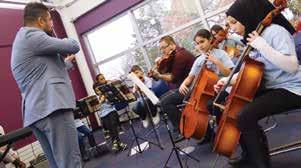
For this, Krzan is grateful. “With all the uncertainty of the world, it has been very reassuring to see how much the KSO board and management are doing to make sure the musicians' well-being is taken care of,” he says. The players
With it being hard to maintain a routine these days, KSO musicians have responded in various ways to the constraints of the pandemic.
Composer and KSO cellist Elizabeth Start admits to being distracted by domestic projects and gardening over the summer — “I am not used to being home all the time!” — but says she enjoyed participating in a Rapido! composition contest, for which she wrote a piece in 14 days to get “unstuck.” She also composed a piece for the KSO anniversary season that she hopes to hear performed in 2021.
“I really look forward to playing somewhere, sometime, for people who are nearby and visible,” she says. “There’s nothing like working towards a common goal with my colleagues. Music has always been a communal thing for me, about connections and collective efforts and, of course, feeling the response of an audience.”
A Kalamazoo native, Start has connections to the KSO’s origins — she delivered newspapers to the KSO’s founder as a child. And as she looks toward the KSO’s future, she sees plenty

Above: Young and old attend the KSO performances, like this one at Miller Auditorium. Left: Members of the KSO’s youth group Orchestra Rouh practice.
of upsides. “I don't think we could have better leadership now than we do, putting us in the best position to move forward in this bizarre and shifting terrain,” she says.
Principal tuba player Robert Whaley joined the orchestra in 1966 and is the KSO’s longest-serving musician. His career has included everything from a solo performance at Carnegie Hall’s Weill Recital Hall that was reviewed by The New York Times to playing the famous here-comes-the-shark riff in the Jaws film soundtrack 35 times during one of the KSO’s movie nights, but he cites a local concert with Bobby McFerrin in 2015 as one of his most memorable moments.
“It was an evening of Gershwin at Miller Auditorium. We had just played Porgy & Bess, when McFerrin walked off the podium, through the musicians, and came right up to me. He said, ‘You play something, and I will imitate you.’ I was stunned, but I played a few little jazz things — and I’m not a jazz player — and he vocalized back. We played and answered each other for a while. It was amazing.”
Whaley thought about retiring after his 50th season, in 2016, during which the KSO staged a tribute to him, but he then learned that the next year’s schedule would include Mahler’s Symphony No. 6.
“It has a great tuba part I’d never played, so I stuck around, and that just keeps happening,” he says, now preparing for his 55th season. “I’m still playing.” Connecting through education
The KSO’s contributions to the community go beyond performing. Education has always been one of its priorities. Among its programs are the afterschool programs Kalamazoo Kids in Tune and Orchestra Rouh (“soul” in Arabic). The latter, implemented in partnership with the Suzuki Academy of Kalamazoo, is led by founder Ahmed Tofiq and designed for children of refugee and recent immigrant families. During the last few months of the 2019-2020 school year, the KSO served students in both programs simultaneously with a focus on maintaining community and connection.
100 YEARS?!

Thank you to the Kalamazoo Symphony Orchestra for enriching our community with music for the past century! We are proud to support your organization. Our horn section salutes you!

“We checked in with the families to make sure their basic needs were met,” says Elizabeth Youker, KSO cellist and director of education and community engagement. “Our team plugged them in to lunch pickups and homework packets, checked on internet access and even shared job postings.”
In mid-March Youker had just returned to work after the December birth of her third child. She was hoping to “ease back into things” — an idea that quickly evaporated when Michigan schools shut down because of the pandemic. Her team pivoted to create online music education through the end of the school year.
“We have been so pleased to continue serving students and families when everything else had seemingly stopped,” she says. “It really gave all of us a lot of hope.”
Private lessons were offered for those who had instruments at home. The team created videos of instructors sharing cues over orchestra recordings so the students could play along using their sheet music. Instead of daily two-and-a-half-hour convenings,
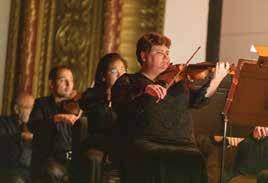
90-minute programs were offered on alternate days in order to avoid “Zoom fatigue.” For students without instruments, Brian Powers teachers shared talks about jazz and the tango, hosted yoga and drawing classes, and shared relaxation and mindfulness techniques.
The education and community engagement team even maintained virtual contact with its youngest students through the Marvelous Music preschool initiative, which, during a normal school year, sends music specialists to 35 classrooms weekly in partnership with the Crescendo Academy of Music, reaching 600 kids.
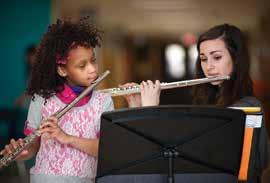
From left: The KSO’s violin section in a performance at Chenery Auditorium; a student and instructor in the Kalamazoo Kids in Tune program; a Craft Music performance at Bell’s Brewery; and students showcase their talents in a performance.
The symphony’s robust schedule of performances in schools, undertaken by eight full-time musicians in residence, also hit a full stop. In what was a typical year, the 2018- 2019 season, the KSO gave 150 performances in more than 100 schools, reaching more than 38,000 students. “The pandemic stopped us in our tracks right before our biggest week: five days of fulllength concerts in front of 14,000 students,”
Our first Gilmore Artist, David Owen Norris, performs with the KSO in 1991.
100 years of musical inspiration! We salute our partner and friend, the Kalamazoo Symphony Orchestra.
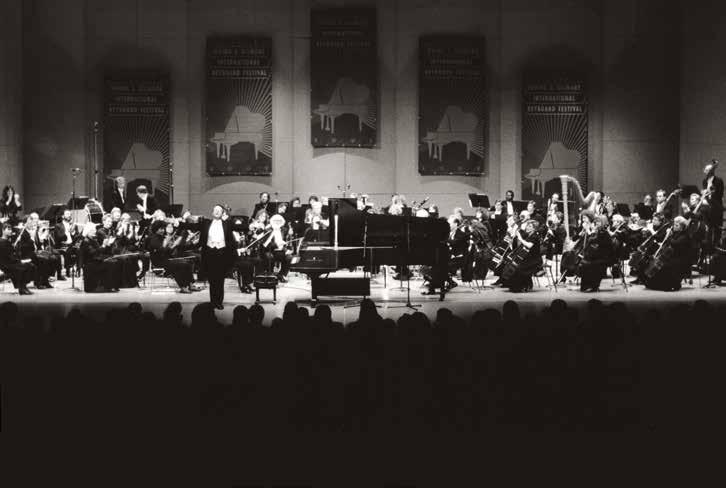
thegilmore.org
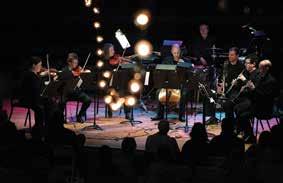
says jazz pianist Rufus Ferguson, who is in his second year as the KSO’s education manager and also teaches music at Western Michigan University. “It completely shifted our concept of programming, but, in a way, it was just what we needed to break traditional modes.
“This fall my hope is that students will still experience the things they look forward to from us in a way that’s meaningful, as the pandemic challenges us to reach our students with 21st-century technology.”
For the new school year, the KSO is creating a virtual classroom that will include instrument introductions, composer biographies, a library of “musical storybooks,”

small ensemble performances, explorations of topics like reed- and mallet-making, tours of area instrument workshops, and both new and archival videos of the full orchestra.
“Our online platform could reach more students by not being bound to a building,” Youker says. Plans for 2021
The KSO plans to resume live performances for audiences in January, with six “Masterworks Concerts” scheduled through June. The audience numbers may be limited and programs held to 90 minutes to eliminate the extended socializing of intermissions. There will be no vocalists, as singing is considered a “superspreading” activity.
Bassist Krzan echoes other KSO members when he says, “I dream of packing together into a large concert hall. I miss the connection with colleagues and our audience. I cannot wait to gather again on stage in performance with everyone together and to have our supportive audiences able to safely take it in.”
Kuerti feels the same. “Our lifeblood is to be on stage and to connect with the public,” he says.
Given the variability of mandates for how many people can convene indoors and requirements for social distancing, each date on the 2021 schedule has Plans A, B and C in place. But Mallow Gulley says she is particularly looking forward to the final concert, planned for June.
“It will be an outdoor production of Beethoven’s Ninth Symphony. The triumph of that work is about overcoming fear and embracing joy together. That’s a powerful message for this year.”
Did Your Doctor Move to Bronson?

On July 1, more than 60 family medicine and pediatric providers moved from Ascension Borgess ProMed to Bronson. Daytime, evening and weekend appointments are available at these seven new office locations. Call (269) 341-7788 or schedule online now at bronsonhealth.com/PrimaryCarePartners.
Bronson Primary Care Partners:
9th St. • 5973 Beatrice, Kalamazoo East Centre • 2700 E. Centre., Portage Galesburg • 10310 Miller Dr., Galesburg Richland • 8906 M-89, Richland Texas Corners • 8088 Vineyard Pkwy., Texas Corners Three Rivers • 601 S. 131, Three Rivers West Main • 6210 W. Main St., Kalamazoo








